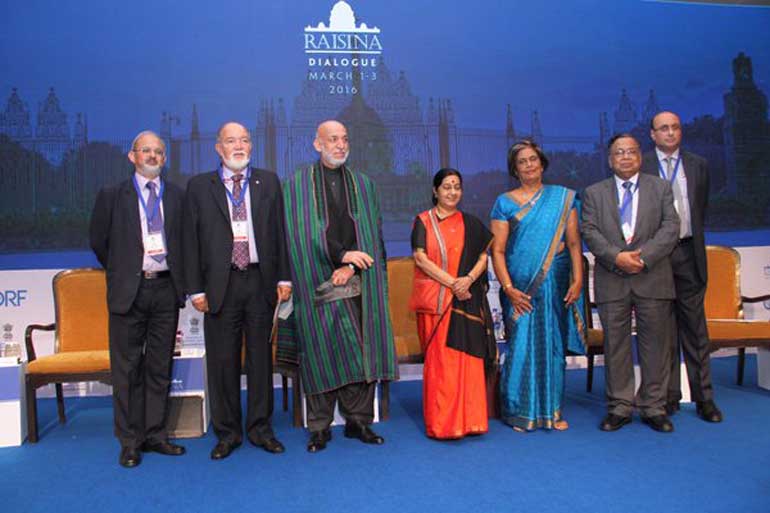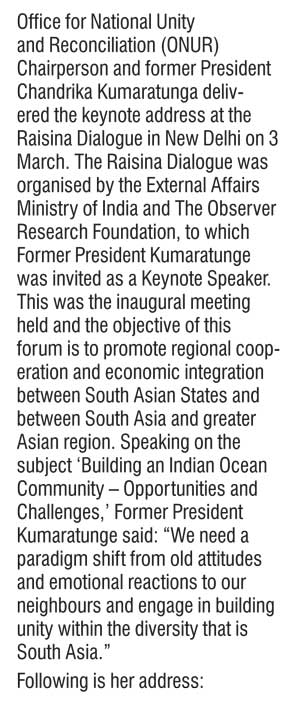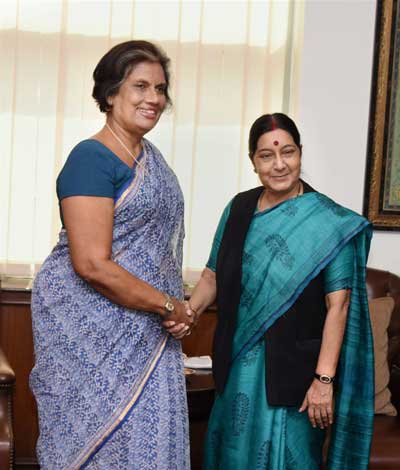Thursday Dec 25, 2025
Thursday Dec 25, 2025
Saturday, 5 March 2016 00:00 - - {{hitsCtrl.values.hits}}

At the Raisina Dialogue 2016 in New Delhi, from left: Former President of Seychelles James Mancham, former President of Afghanistan Hamid Karzai, Foreign Minister of India Sushma Swaraj, former President of Sri Lanka Chandrika Bandaranaike Kumaratunga and Foreign Minister of Bangladesh Mohammed Ali
 The subject of South Asian regional cooperation has been widely discussed for many decades. However, progress in regional cooperation and economic integration has been extremely slow. Political will seems to be lacking, public interest is weak and no country in South Asia has taken up the subject of regional integration as a government policy.
The subject of South Asian regional cooperation has been widely discussed for many decades. However, progress in regional cooperation and economic integration has been extremely slow. Political will seems to be lacking, public interest is weak and no country in South Asia has taken up the subject of regional integration as a government policy.
The reasons for this are well known.
However, the past two decades has seen the rise of the post-partition generations in South Asia giving rise to a new and more dynamic environment for understanding between nations. This generation has left behind the baggage of conflict and distrust borne by the older generations. They are seeking new paradigms and creative thinking.
I wish to repeat a fact which I am sure most of you are aware of. South Asia is the least integrated region in the world. In the globalised world, where not only economic borders but physical borders are fast disappearing, South Asian nations have managed to remain isolated from each other.
We know that low levels of trade, investment and other forms of economic cooperation cause higher input costs at production, smaller export markets, reduced revenues for governments and reduced consumer welfare. Yet South Asia has significant inter regional trade potential. Research demonstrates that there could be considerable increases in growth and welfare arising from closer regional cooperation.
The positives for regional cooperation is that the fastest growing economy in the world is India. It is predicted that the Indian economy will grow at 7.5 % and reach double digits in a few years. India will have much to gain through regional integration, as much as the other countries in the region.
What do we need to do to achieve closer cooperation? I believe that we do not need a grand vision but instead a pragmatic action plan. I must hasten to add here that only pragmatism may not suffice to overcome the existing challenges of building mutual trust  and progressing towards integration. A common objective will certainly help to cement the practical move in a durable fashion. European integration was born out of a common desire to prevent the massive destruction of the two World Wars from occurring once again.
and progressing towards integration. A common objective will certainly help to cement the practical move in a durable fashion. European integration was born out of a common desire to prevent the massive destruction of the two World Wars from occurring once again.
South Asia could perhaps coalesce around the need to conquer the challenge of extremism, violence and terrorism. This vision could also en-globe the following practical aspects:
The major preoccupation of all South Asian nations since de-colonisation has been their quest for a national identity, as opposed to the regional identity which has existed for millennia. The desire to differentiate the identity of one’s nation from the millennial common regional identity gave rise to many violent inter-state and inter-state conflicts in the region. We need a paradigm shift from old attitudes and emotional reactions to our neighbours and engage in building unity within the diversity that is South Asia.
In the emerging regional environment, national security concerns should compel us towards more cooperation rather than becoming an argument against cooperation.
 There is no doubt that cooperation in the economic and cultural spheres and people-to-people contact would promote an atmosphere of pacification and hence less security concerns.
There is no doubt that cooperation in the economic and cultural spheres and people-to-people contact would promote an atmosphere of pacification and hence less security concerns.
We could look at creating pluri-lateral security frameworks.
It is clear that the need for South Asian integration is urgent. We should no longer waste great cultural and human potential of our region and lock ourselves into a destructive chase of better identities than our neighbours. Let us seek to build on our historical, geographical and civilisational advantages to lift our region out of poverty and inequality and march towards freedom and prosperity.
In order to achieve this we need to engage in a series of practical actions, such as an effective South Asian Free Trade Agreement (SAFTA). To make SAFTA effective we would have to:
I wish to express some thoughts on Sri Lanka’s possible role in these exercises:
Could we not consider the Chinese economic power as an opportunity rather than a danger and arrive at partnerships that could be beneficial to the South Asian countries as well as our region?